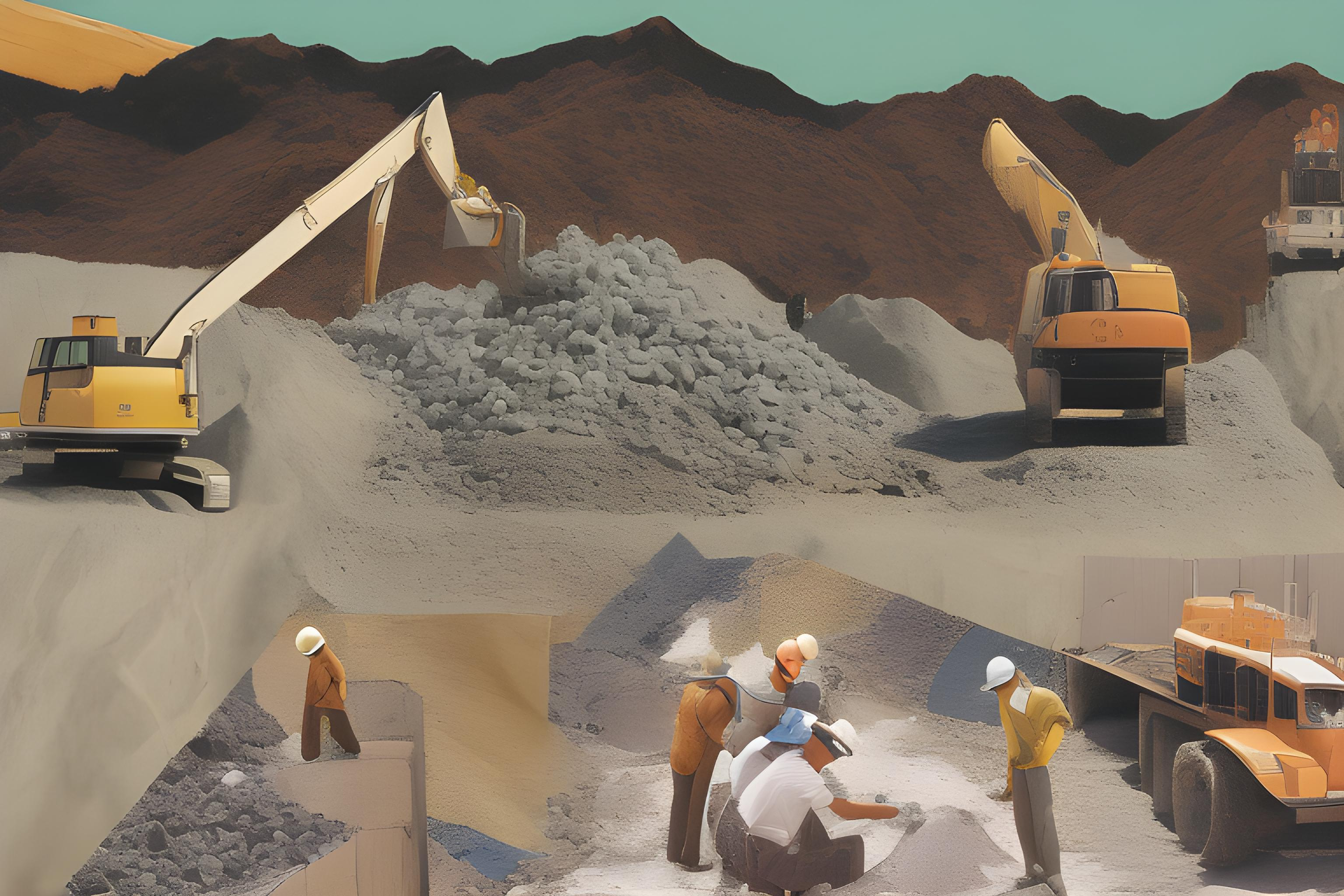Since the very beginning, Burgex has helped shape AggNexus with one goal in mind: creating meaningful, impactful conversations in the aggregates and concrete space.
Contact Us Today
Contact Us Today
Since the very beginning, Burgex has helped shape AggNexus with one goal in mind: creating meaningful, impactful conversations in the aggregates and concrete space.
Mineralocity is more than just a platform; it’s a reflection of our core mission: to solve the challenges of mining. We know how difficult this industry can be to navigate. Whether you are at the beginning of an idea or managing an established operation, you don’t have to do it alone.
Explore the top 25 U.S. counties by estimated aggregate demand in 2024. Learn how construction trends, infrastructure investments, and population growth are driving demand for aggregates across key regions.
Investing in an aggregate operation holds considerable promise. The industry’s pivotal role in infrastructure development means there’s always potential for profits. Yet, like all industries, the aggregate sector isn’t without its pitfalls, especially for the uninformed investor. The importance of due diligence can’t be overstated, and here’s why.
Every operation, on the surface, has its way of projecting efficiency and promise. However, delving deeper can sometimes reveal operational issues that can directly impact the return on investment and overall efficiency.
Obsolete Equipment: Without proper examination, you might find that much of the equipment is outdated or frequently malfunctioning. The cost of updating machinery can quickly eat into expected profits.
Sub-Optimal Mine Plans: Even if an operation appears profitable on the surface, a lack of strategic mine planning can lead to inefficient extraction, escalating costs, and diminishing returns.
Unexplored Expansion Potential: Without detailed assessment, investors might miss out on understanding the full potential for expansion or additional extraction sites.
Safety Concerns: Overlooking the safety protocols might mean the operation has a history of accidents, which can result in high insurance costs and potential lawsuits.
In the world of aggregate operations, the regulatory landscape is intricate. An overlook, intentional or otherwise, on regulatory and compliance matters can lead to significant unexpected costs, legal battles, or even a halt in operations.
Permitting Issues: While the operation might currently be running, they could be doing so without the proper permits or might be near the expiration of their permit without a clear renewal path.
Environmental Concerns: A lax approach to environmental responsibilities might have left the operation open to potential lawsuits or expensive cleanup processes.
Land Reclamation: Not having a clear plan for land reclamation after extraction can result in high unforeseen costs and potential legal implications.
Zoning Restrictions: There might be restrictions on the expansion or the kind of activities that can be carried out, impacting the future growth potential.
Valuing an aggregate operation isn’t just about crunching numbers. It’s about understanding the geological, operational, and financial intricacies that interplay to provide an accurate picture of the operation’s worth.
Overestimating Reserves: Without thorough geological studies, there’s a risk of overestimating the amount of material available for extraction. This can considerably affect the operation’s long-term profitability.
Hidden Liabilities: Previous accidents, disputes, or unresolved claims can lead to unexpected financial drains.
Underestimating Operational Costs: The operation’s costs might be higher than industry standards, reducing the profit margin.
Debt Load: The operation could have undisclosed or underestimated debts that could affect the profitability and overall valuation.
The demand for aggregates doesn’t exist in a vacuum. It’s tied directly to the ebbs and flows of local, national, and global economies, construction trends, and more. A misjudgment in this arena can severely skew profitability projections.
Overestimating Demand: Without proper analysis, there’s a risk of overestimating the local demand for aggregates, leading to surplus production and reduced prices.
Underestimating Competition: Failing to account for the competitive landscape can leave investors blindsided by aggressive competition, affecting market share and profitability.
Shifts in Construction Trends: Changes in construction methods or preferences can influence the demand for specific aggregates.
Economic Downturns: Local or global economic situations can influence construction projects and, subsequently, aggregate demand.
Behind every successful aggregate operation is a team of dedicated professionals. However, underlying issues in management, team dynamics, or skill levels can introduce instability and inefficiency in the operation.
Skill Shortages: It’s possible that the current team lacks the necessary skills or training to run operations efficiently.
Management Discord: Underlying issues among the management team or between management and staff can result in operational inefficiencies or even halts.
Employee Turnover: High turnover rates can indicate deeper operational or management issues and result in inconsistency in production.
Lack of Succession Planning: Not having a plan for future leadership can jeopardize the long-term stability of the operation.
As enticing as the prospect of investing in an aggregate operation might be, it’s essential to dive deep beneath the surface. The risks of not conducting thorough due diligence are not only varied but can also be financially devastating. Expertise in the form of industry consultants, such as Burgex Mining Consultants, and tools like Mineralocity Aggregates, becomes invaluable in these situations. With their comprehensive knowledge and tools, they ensure that your investment is built on solid ground, minimizing risks and optimizing potential returns.
In the realm of construction aggregates, producers are constantly on the lookout for strategies to optimize production, reduce costs, and maintain quality. While establishing new sites can bring about fresh opportunities, there’s also great potential lurking beneath existing operations. By “digging deep” into your current site, you can unearth ways to enhance production and ensure the longevity of your operations. Here’s how:
Optimal equipment utilization is about much more than just using machinery. It’s about understanding, adapting, and innovating to ensure that every piece of equipment contributes effectively to the production goals. By focusing on these areas, you can ensure you’re getting the maximum return on equipment investments.
Maintenance and Upkeep: Regularly maintaining your equipment ensures it runs at its optimum capacity. Scheduled checks, preventive maintenance, and timely replacements of worn-out parts can prevent unexpected downtimes, ensuring consistent production rates.
Maximizing Equipment Runtime: By scheduling shifts efficiently and minimizing downtime, you can get the most out of your equipment. This might involve using real-time monitoring systems to identify and rectify issues before they escalate.
Capacity Matching: Ensure that the equipment used is suited for the job’s size and scope. Using equipment that’s too large can lead to unnecessary capital and operational expenses, while equipment that’s too small might not meet production demands.
Training Operators: An equipment piece is only as good as its operator. Training sessions for operators not only ensure safety but also ensure that machinery is used efficiently and optimally. It can significantly reduce operational errors that lead to wear and tear or reduced output.
Evaluate & Upgrade: The aggregate industry, like many others, is continually evolving with the introduction of new technologies. Periodically evaluating and potentially upgrading to more efficient or automated machinery can offer better production rates and reduce costs in the long run.
Custom Solutions: Sometimes, off-the-shelf equipment might not be the best fit for your specific needs. Considering custom solutions or modifications to existing equipment can significantly enhance production capabilities tailored to your site’s unique characteristics.
Training Programs: Equip your team with the skills to operate machinery optimally. Continuous training programs can lead to improved efficiency and reduced waste.
Optimize Workflow: Review your current operational flow. Identify bottlenecks and strategize on how to eliminate them to achieve a more streamlined production process.
Re-evaluate Extraction Methods: Depending on the geological nature of your site, switching up your extraction methods might yield better results. Consider methods that minimize waste and ensure a higher recovery of materials.
Recycling and Reuse: Consider investing in equipment that can recycle used aggregates. This not only reduces waste but can also lead to cost savings in the long run and has proven to be a great business model within metro areas.
Advanced Testing: Embrace advanced testing methods to ensure that your aggregates meet industry standards. This will help maintain client trust and reduce the chances of product returns. You may also find that your resource has the potential to produce additional products and open new potential markets.
Feedback Loops: Create a system where feedback from the end-users of your aggregates is actively collected and acted upon. This can lead to improvements in product quality and better meet market demands.
Site Assessment: Continually assess your site to identify untapped sections that might contain high-quality aggregates. Techniques such as exploratory drilling can offer insights into the depth, extent, and quality of these reserves.
Update or Create Mine Plans: If you’re operating based on older mine plans, it might be time for a revisit. As technology advances and new data becomes available, mine plans can be refined for better optimization. An updated mine plan can help pinpoint exact locations for extraction, ensuring minimal waste and efficient resource utilization.
Lacking a Plan?: If your operation hasn’t had a formal mine plan in place, now is the perfect time to develop one. A well-crafted mine plan guides operations, ensuring that resources are extracted in a logical and sustainable manner. It can also act as a roadmap for future expansions, helping operations forecast potential obstacles and opportunities.
Collaboration with Geologists and Engineers: To create or refine a mine plan, it’s beneficial to collaborate with geologists and mining engineers. Their expertise can help make sense of the data gathered from exploratory drilling and other assessment methods, transforming it into actionable strategies.
Regulatory Compliance: Updated mine plans can also ensure that your operations stay in line with local and federal regulations. This can help avoid potential legal hurdles and ensures the sustainability of your operations in the long run.
Hiring Consultants: Bringing in external expertise, like Burgex Mining Consultants can provide fresh perspectives on your operations. They can identify areas of improvement that might have been previously overlooked and provide strategies to tap into them.
Investing in technology doesn’t mean just buying the latest gadgets. It means integrating modern tools and approaches into the aggregate production process to enhance efficiency, reduce costs, and increase output. In the rapidly evolving technological landscape, staying updated and making informed tech investments can give aggregate producers a competitive edge.
Automation: As the industry progresses, automation solutions have become more accessible and practical. Automated systems in production, loading, and transport can significantly improve efficiency and reduce labor-intensive tasks. Automated crushers, for instance, can optimize rock crushing, and automated conveyor belt systems can increase the transport speed of materials.
Real-time Monitoring: Deploy sensors and equipment fitted with IoT (Internet of Things) capabilities. These can provide real-time data about equipment health, production rates, and operational inefficiencies. By identifying issues as they arise, producers can make instantaneous adjustments, leading to consistent and optimized production.
Data Analytics: With the large volumes of data generated from real-time monitoring, utilizing data analytics can offer actionable insights. By analyzing patterns, you can anticipate maintenance needs, adjust for efficiency, and forecast production capabilities.
Drones: Utilize drones for site mapping, stockpile measurements, and monitoring. Drones can provide accurate data faster and more safely compared to manual inspections, enabling better decision-making.
Software Solutions: Invest in software tailored for the aggregate industry. Software solutions can aid in tasks ranging from inventory management and production tracking to predictive maintenance and financial forecasting.
Sustainable Technologies: With increasing emphasis on sustainability, look into technologies that reduce emissions, recycle water, and minimize waste. For instance, electric-powered equipment might offer a sustainable alternative to diesel-powered machinery in certain applications.
Mobile Applications: Equip your on-ground teams with mobile applications that allow them to report, monitor, and communicate more effectively. This can significantly streamline operations and improve response times to any challenges that arise.
Enhancing production in existing aggregate sites is all about understanding your current resources and optimizing them. With a keen focus on continuous improvement and a willingness to adapt to modern methods and technologies, producers can ensure that their sites continue to yield high-quality aggregates for years to come. For those looking to dive even deeper into the nuances of the aggregate market, tools like Mineralocity Aggregates offer invaluable insights to stay ahead in this dynamic industry.
When an astute investor peers into the realm of the U.S. construction aggregate industry, they’re not just looking at the surface. Their lens might focus on a spectrum of opportunities – from purchasing stocks in established public companies to diving deeper with private equity or even a direct investment into a burgeoning operation or enterprise. This dynamic and multifaceted sector has been gaining attention, and for good reasons. With the rise of construction projects and an increasing demand for concrete and aggregates, it beckons the question: Is this industry ripe for long-term investment? Let’s unpack recent data and insights to get a clearer picture.
The recent earnings from some of the major players in the construction aggregate industry have been nothing short of impressive:
– Vulcan Materials (VMC) outperformed with its Q2 earnings, surpassing estimates and bringing in a whopping $1.43 billion in revenue. Crediting its success to the consistent demand backed by the U.S. construction market’s recovery, the company seems optimistic about the future. Its decision to up its full-year guidance for earnings signals confidence in sustained demand and is further bolstered by strategic acquisitions like that of Ash Grove Cement.
– Martin Marietta Materials (MLM), not to be left behind, reported stellar Q2 earnings and a revenue of $1.48 billion. Mirroring Vulcan’s sentiments, Martin Marietta acknowledges the role of the recovering U.S. construction market in these results. Their decision to raise their full-year guidance suggests that they too see a positive trajectory for the industry.
– Eagle Materials (EXP) continues the trend with impressive Q2 earnings and revenue surpassing estimates. Their upward revision of the full-year guidance, coupled with recent acquisitions, highlights their bullish outlook on the industry’s future.
(Source: Seeking Alpha)
Beyond individual companies, broader industry reports also paint a promising picture. A recent projection by the *American Concrete Institute (ACI)* foresees a 4.5% growth in U.S. concrete production for 2023. This uptick is attributed to the recovering U.S. construction market, the pressing need to refurbish the nation’s infrastructure, and the burgeoning renewable energy industry.
This expected spike in concrete production inevitably points to a subsequent rise in demand for construction aggregates. Consequently, U.S. construction aggregate producers stand to gain significantly, with increased sales and profits on the horizon.
As with any investment, it’s imperative to consider the risks. For U.S. construction aggregate producers, potential challenges include fluctuating demand, governmental regulations, and environmental concerns. However, as current trends suggest, the rewards of investing in this sector could very well eclipse these risks, especially given the anticipated growth in the U.S. construction domain.
In the complex landscape of investments, having the right tools and insights can make all the difference. Enter Mineralocity Aggregates. As the construction aggregate industry presents itself as a promising investment avenue, understanding intricate details such as market share becomes crucial. With over 800 labor hours poured into each data update, Mineralocity Aggregates ensures you have the most current and comprehensive insights at your fingertips. Make well-informed investment decisions and stay ahead of the curve with Mineralocity Aggregates, your trusted partner in the aggregates industry.






